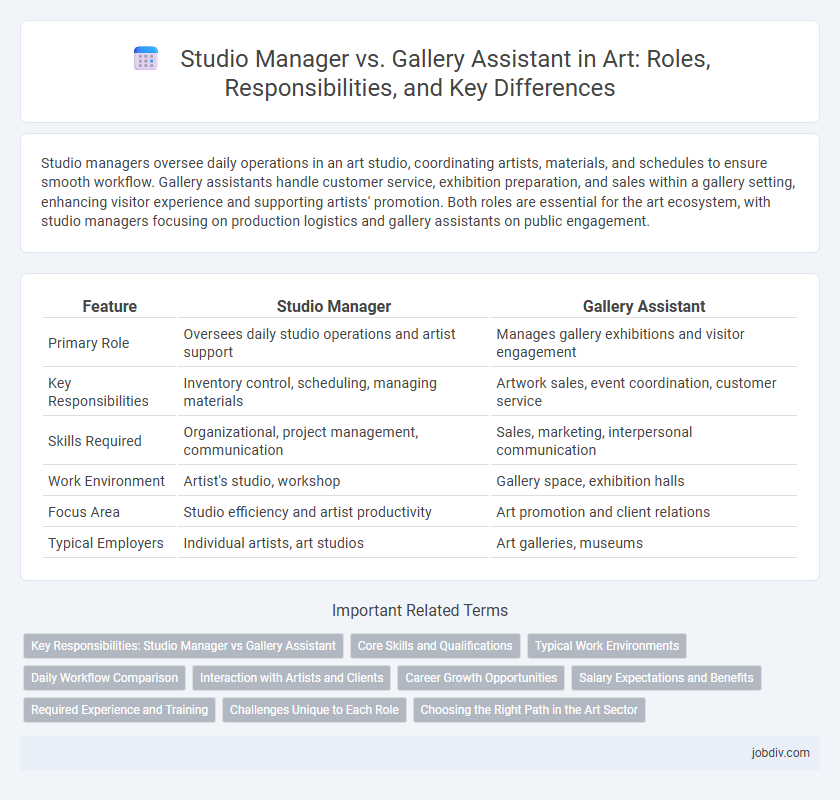Studio managers oversee daily operations in an art studio, coordinating artists, materials, and schedules to ensure smooth workflow. Gallery assistants handle customer service, exhibition preparation, and sales within a gallery setting, enhancing visitor experience and supporting artists' promotion. Both roles are essential for the art ecosystem, with studio managers focusing on production logistics and gallery assistants on public engagement.
Table of Comparison
| Feature | Studio Manager | Gallery Assistant |
|---|---|---|
| Primary Role | Oversees daily studio operations and artist support | Manages gallery exhibitions and visitor engagement |
| Key Responsibilities | Inventory control, scheduling, managing materials | Artwork sales, event coordination, customer service |
| Skills Required | Organizational, project management, communication | Sales, marketing, interpersonal communication |
| Work Environment | Artist's studio, workshop | Gallery space, exhibition halls |
| Focus Area | Studio efficiency and artist productivity | Art promotion and client relations |
| Typical Employers | Individual artists, art studios | Art galleries, museums |
Key Responsibilities: Studio Manager vs Gallery Assistant
A Studio Manager oversees daily operations within an artist's workspace, coordinating schedules, managing inventory, and ensuring efficient material procurement to support creative processes. In contrast, a Gallery Assistant handles client relations, artwork presentation, and sales transactions, maintaining the gallery's public image and facilitating exhibitions. Both roles require strong organizational skills, but the Studio Manager emphasizes internal workflow management while the Gallery Assistant prioritizes customer engagement and public interaction.
Core Skills and Qualifications
Studio Managers require strong organizational and project management skills, proficiency in inventory tracking, and expertise in overseeing art production workflows. Gallery Assistants need excellent customer service abilities, knowledge of art sales processes, and experience with exhibition setup and client relations. Both roles benefit from art history knowledge, attention to detail, and proficiency in digital cataloging tools.
Typical Work Environments
Studio Managers typically work in artist studios, overseeing daily operations, managing schedules, and coordinating with clients to ensure smooth project execution. Gallery Assistants often operate within gallery spaces, handling exhibitions, assisting visitors, and managing sales transactions. Both roles require adaptability to dynamic art environments but differ in workspace focus and interaction levels.
Daily Workflow Comparison
Studio Managers oversee the entire creative process by coordinating artists' schedules, managing supplies, and ensuring timely project completion, while Gallery Assistants focus on daily operations such as handling artwork installations, client interactions, and sales transactions. The Studio Manager's workflow involves strategic planning and inventory management, often using project management software, whereas the Gallery Assistant engages in front-of-house tasks, maintaining the gallery's presentation and assisting visitors. Both roles require strong organizational skills but differ in their primary focus--production oversight versus customer engagement within the art industry.
Interaction with Artists and Clients
Studio Managers coordinate artist schedules and facilitate communication between artists and clients to ensure seamless project execution, often handling logistical details and resource management. Gallery Assistants engage directly with clients, providing detailed information about artworks and managing sales inquiries while supporting artists by organizing exhibitions and maintaining artist relations. Both roles require strong interpersonal skills, but Studio Managers focus more on behind-the-scenes coordination, whereas Gallery Assistants prioritize frontline client interaction and gallery presentation.
Career Growth Opportunities
Studio Managers often have broader responsibilities including overseeing art production schedules, managing budgets, and coordinating with artists, providing pathways to senior managerial roles or creative director positions. Gallery Assistants typically handle day-to-day operations such as visitor engagement, artwork installation, and sales support, which can lead to careers in gallery management or curatorial roles. Career growth in art studios favors hands-on project management and leadership experience, while gallery roles emphasize networking and sales proficiency for advancement.
Salary Expectations and Benefits
Studio Managers typically earn between $50,000 and $70,000 annually, reflecting their responsibility for overseeing daily operations and managing artists' schedules. Gallery Assistants usually have a lower salary range, around $30,000 to $45,000, as their duties focus on customer service, sales support, and exhibition setup. Benefits for Studio Managers often include health insurance, paid time off, and performance bonuses, whereas Gallery Assistants may receive more limited benefits, such as employee discounts and part-time health plans.
Required Experience and Training
A Studio Manager typically requires extensive experience in art production and project coordination, often demanding a background in fine arts or studio management, along with strong organizational skills. In contrast, a Gallery Assistant generally needs foundational knowledge of art history and customer service, with training often consisting of internships or entry-level roles in gallery operations. Both roles benefit from familiarity with art handling and sales, but the Studio Manager role emphasizes leadership and technical expertise, while the Gallery Assistant focuses more on client interaction and administrative support.
Challenges Unique to Each Role
Studio Managers navigate complex logistics including supply chain management, artist scheduling, and maintaining a conducive creative environment, requiring strong organizational skills and adaptability to artists' evolving needs. Gallery Assistants face challenges such as engaging diverse visitors, managing art sales, and curating exhibitions that resonate with audiences, demanding excellent interpersonal skills and market awareness. Both roles are integral to the art ecosystem but require distinct skill sets tailored to operational versus customer-focused responsibilities.
Choosing the Right Path in the Art Sector
Studio Managers oversee art production workflows, coordinate schedules, and manage artist relations, ensuring efficient creation and delivery of artworks. Gallery Assistants support exhibition setups, handle sales transactions, and engage with visitors, fostering a direct connection between artists and art buyers. Selecting between these roles depends on whether you prefer behind-the-scenes operational management or front-facing gallery interaction within the art sector.
Studio Manager vs Gallery Assistant Infographic

 jobdiv.com
jobdiv.com